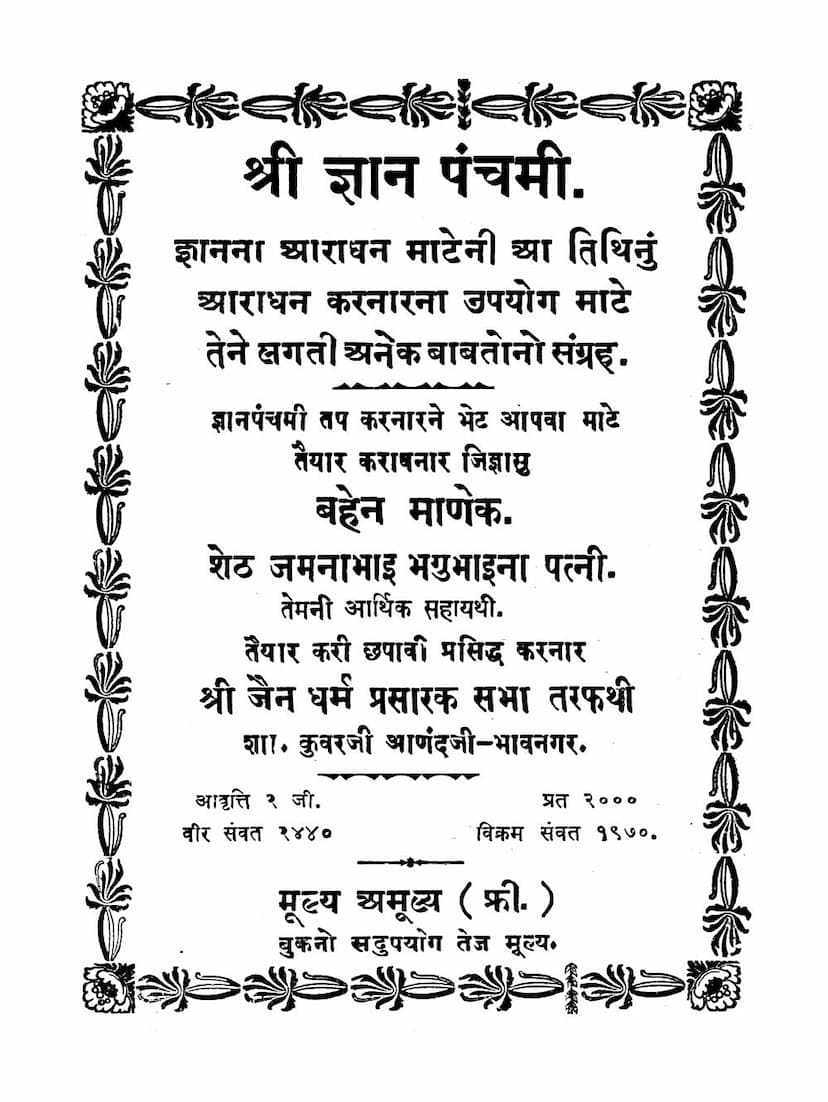Gyanpanchami
Added to library: September 1, 2025

Summary
This document, "Gyanpanchami," authored by Manek Bahen and published by Jain Dharm Prasarak Sabha, is a comprehensive guide dedicated to the observance of the Jain festival of Gyanpanchami. It details the significance, rituals, and devotional practices associated with this day, which is primarily focused on the veneration and pursuit of spiritual knowledge (Gyan).
The book was prepared by Manek Bahen, wife of Seth Jamnabhai Bhagubhai, with financial assistance from Seth Jamnabhai Bhagubhai. The second edition was published in Veer Samvat 2440 (Vikram Samvat 1970), with 2000 copies. The publication aims to provide valuable resources for those observing the Gyanpanchami fast.
Key Aspects Covered in the Book:
-
Significance of Gyanpanchami: The text emphasizes that this day is an excellent means for realizing the soul's inherent knowledge, which has been obscured by knowledge-obscuring karmas since time immemorial. The observance aims to shed these karmas and illuminate true knowledge.
-
Methodology of the Fast (Tapas):
- The fast is typically observed starting from the Kartik month's Shukla Panchami, also known as "Saubhagya Panchami."
- It is primarily undertaken by devoted disciples, both male and female, and ascetics (Sadhus and Sadhvis) who are eager to gain knowledge.
- The fast can be observed for five years and five months, and can be performed through Ekasana (one meal a day), Ayambil (eating food boiled with souring agent), or fasting.
- Those with strong physical capacity are encouraged to observe complete fasts. Even those who cannot fast for the entire duration are encouraged to fast on Kartik Shukla Panchami and observe a Poushadh (fast with strict vows) for eight prahars (time divisions of a day).
-
Daily Rituals during the Fast:
- Perform Ekasana, Ayambil, or fast according to one's capacity.
- Perform Pratikraman twice.
- Worship the Lord with three kalas (times of the day) using eight praises and five Stotras (like Shakrastavadi).
- Perform Padilehan (purification of the place and utensils) twice.
- Perform Jin Pooja (worship of the Jina idols) three times daily: in the morning with Vasakshep (sandalwood paste), in the afternoon with Ashtaprakari (eight types of offerings), and in the evening with incense and lamps.
- Recite "Namo Nanasya" (Obeisance to Knowledge) 2000 times with concentration.
- Observe Poushadh if possible, or spend a significant part of the day in meditation and contemplation of knowledge.
- Practice devotion to knowledge and the knowledgeable (Gyanis).
- Study knowledge and avoid its disrespect.
- Light five lamps before the Lord or knowledge, draw five Swastikas, and offer five fruits and sweets according to one's capacity.
- Perform Kaushagg (meditative posture) for five or fifty-one logs (slokas).
-
Special Observances on Gyanpanchami Day:
- Perform all the above rituals with increased devotion.
- Perform special Angi Pooja (consecration worship) of the Jina idols.
- Offer special fruits and sweets.
- Worship the special deities associated with Gyanpanchami.
- Observe fifty-one fasts.
- Perform Kaushagg for fifty-one logs.
- Observe Poushadh for the entire day.
- Spend the entire day in contemplation of knowledge.
- To honor knowledge, adorn appropriate places with beautiful canopies and gates, making it attractive for many to visit and pay homage.
- Engage in singing and chanting of devotional songs before knowledge, and arrange for others to do so as well.
- Encourage many virtuous individuals to actively participate in the adoration of knowledge.
-
Gyanachara (Conduct related to Knowledge):
- The book elaborates on the eight types of Gyanachara, as outlined in the "Shri Achar Pradip" text, which include Kala (Time), Vinay (Respect/Humility), Bahumana (Esteem), Upadhana (Purificatory Rituals), Aninhava (Non-concealment), Vyanjana (Scripture/Letters), Artha (Meaning), and both Vyanjana and Artha.
- It includes detailed explanations and illustrative stories for each of these conduct types, such as the story of King Prithipal, the story of Bruhatkumari, and the story of two disciples of a Siddha-putra, to explain the importance of adhering to these principles.
-
Devotional Compositions:
- The book contains a collection of devotional pieces for Gyanpanchami, including:
- Gyanashtaka by Shri Yashovijayji and Shri Haribhadra Suri.
- Shri Panch Gyanani Puja (worship of the five types of knowledge) by Shri Rupavijayji.
- Pujas extracted from Shri Vijayalakshmi Suri's "Vishasthanak ni Puja" and Shri Atmaramji Maharaj's "Vishasthanak ni Puja."
- Gyanapad Puja from Shri Yashovijayji's "Navpad ni Puja," and similar works by Shri Padmavijayji, Shri Atmaramji, Pandit Shri Gambhirvijayji, and Shri VeerVijayji.
- A song from the "Pistalish Agam ni Pragya."
- Chaitra Vadi Panchami Ni Chaityavandan, Shri Gyanpanchami nu Stavan, Shri Panchami ni Stuti, Shri Gyanpanchami nu Laghu Stavan, Shri Gyanpanchami ni Sanskrit Stuti (with meaning), Shri Devavijayji Krit Panchamani Sajhay, Shri Gyanpanchami nu Stavan (by Samaysundarji), and Shri Vijayalakshmi Suri Krit Panchamani Sajhay.
- Special Devavandan and its meaning for Gyanpanchami.
- The book contains a collection of devotional pieces for Gyanpanchami, including:
-
Ujman (Celebration/Feast) Rituals:
- The book provides a detailed description of the Ujmana vidhi, the activities to be performed for the celebration, and the items to be offered during the Ujmana. This includes guidelines for constructing altars, offering various items, and performing auspicious rituals.
-
Types of Gyanpanchami Fast: The text outlines three types of fasts for Gyanpanchami:
- Laghu Panchami Tap: Observing fasts on Shukla Panchami and Krishna Panchami of any month for one year, except for Paush and Chaitra.
- Gyanpanchami Tap: Observing the fast for five years and five months, typically on Shukla Panchami of specific months (Magh, Fagun, Vaishakh, Jyeshth, Ashadh, and Kartik).
- Utkrusht Panchami Tap: Observing the fast throughout one's life, fasting on every Shukla Panchami.
The book concludes with detailed explanations of various devotional hymns, prayers, and the underlying meanings, all aimed at enhancing the spiritual experience of observing Gyanpanchami and fostering a deeper connection with knowledge and its principles within Jainism. The preface also highlights the book's purpose as a spiritual offering and a means to encourage the observance of this important fast.